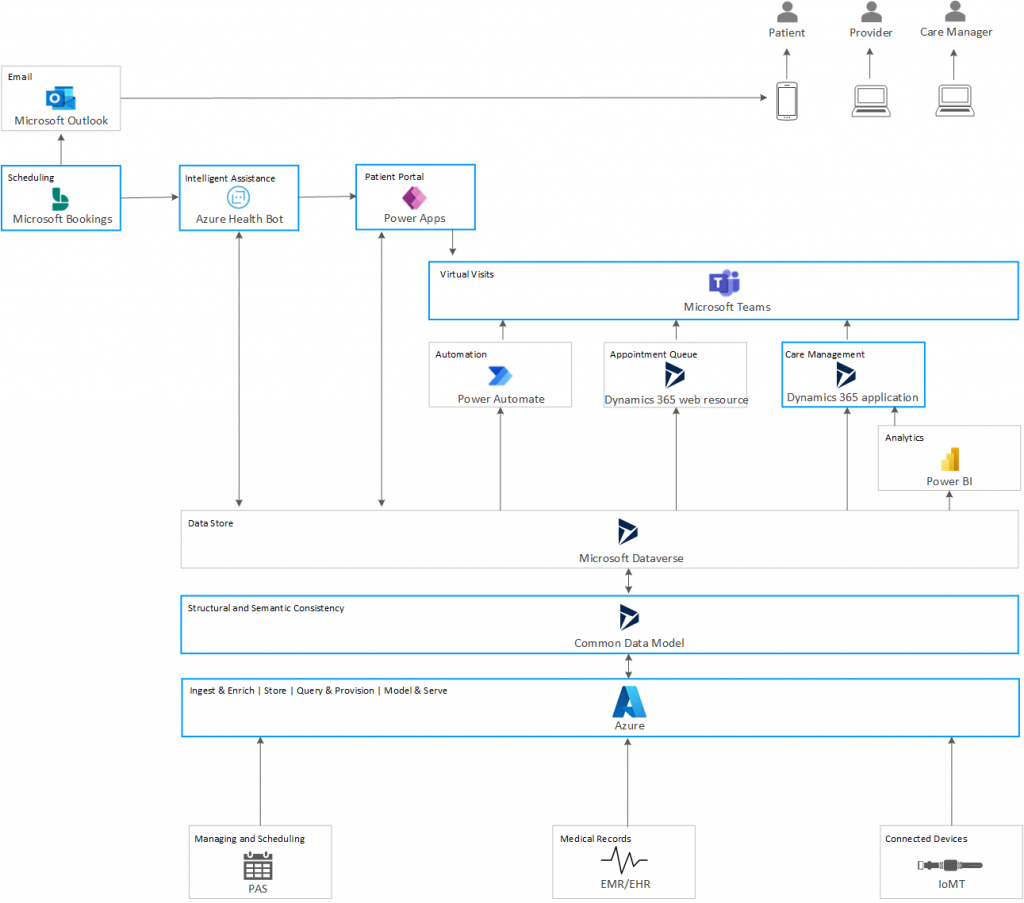The pandemic accelerated the shift in healthcare towards Telehealth. Telehealth is the IT-enabled augmentation of Healthcare services that aim at substitution of traditional face-to-face mode of patient-provider interaction. An extension of telehealth also involves provider-provider interaction when a patient-provider interaction requires specialist services from other providers.
Telehealth does not aim to replace the backend workflows of healthcare; rather it aims to improve the experience and ease of patient access to care and better utilize specialist provider’s time and resources.
Other terms like remote health, virtual care, tele medicine can be used almost synonymously. We will use the term ‘Telehealth’ for uniformity in the rest of the article.
Key Components of Telehealth
Teleconsultation: This is one of the most widely known categories of telehealth. It basically refers to the online consultation between a doctor and a patient. It can be done through videoconferencing, live chat, etc. This also includes mobile health where healthcare interactions are conducted using a handheld device like a smart phone or tablet.
Telemonitoring: In this case, a doctor receives health data from a patient, while connected to a biosensor. It can be done through an electronic scale, a vital-sign monitor, a glucometer, or any other device that can effectively monitor bio-parameter. The doctor will then use the results they have obtained from the test to start the treatment or prescribe drugs to the patient. This form of telemedicine allows a patient to be easily monitored from home or a nearby facility, without having to travel a lot.
Role of EHR Integration
The above-mentioned components will be meaningful only if integrated with the existing clinical workflows and backend patient data. This component also includes richer Analytics and AI integration.
EHR and telehealth, when used together, can significantly improve the care delivery system.
Some of the major advantages of Telehealth EHR Integration are mentioned below:
- Automates the data entry process and relieve the medical staff of time-consuming efforts
- Gets the complete patient history along with insurance information during the teleconsultation and ensures that critical details are not missed out on
- Provides a seamless experience for patients and doesn’t require patients to keep track of all their past information and documentation
Telehealth Architectures
Cloud platform players like Microsoft Azure have built reference architectures for building telehealth applications. These reference architectures utilize best of components from the cloud platform and fit them together for multiple use cases.
The architectures mentioned below are reproduced from Microsoft site for reference purposes.
The following architecture supports the need for teleconsultation using video conferencing between provider and patients along with helping schedule appointments.

There are multiple components that are part of this architecture that realize the features of teleconsultation solution.
Microsoft Teams: The front end for interactions between the patients, providers, and other healthcare professionals.
Patient Portal: The portal for patients to view their medical records, book appointments, chat with the health bots, etc.
Bookings App: Bookings App is a Microsoft 365 service, included in the Microsoft Cloud for Healthcare. It facilitates the scheduling of calendar events and allows creating meetings on MS Teams.
Electronic Medical Records (EMR) and Electronic Health Records (EHR): EMR/EHR provides the digital records of a patient’s medical and health information, including diagnoses, medications, immunizations, etc.
Azure API for FHIR. Azure is the first step in the process of bringing data into the Microsoft ecosystem and the Microsoft Cloud for Healthcare.
Power BI Analytics. This is an analytics tool and is not available with Microsoft Cloud for Healthcare.
We need to build solutions for telemonitoring as well which is realized by the following architecture.
Remote patient monitoring provides the ability to gather patient health data outside of traditional healthcare settings. Healthcare institutions can use Azure IoT Connector for FHIR to bring health data generated by remote devices into Azure API for FHIR. This data could be used to closely track patients’ health status, monitor patients’ adherence to the treatment plan and provide personalized care.
Use of IoMT devices has seen a marked uptick in healthcare. Azure IoT Connector for FHIR is designed to bridge the gap of bringing multiple devices’ data with security and compliance into Azure API for FHIR.

The IoMT FHIR Connector for Azure can ingest IoT data from most IoT devices or gateways regardless of location, data center or cloud.
The Role of Telehealth Kiosks
While the services part of Teleconsultation like video conferencing, scheduling, document file sharing is good enough for basic enquiries, providers usually need additional information, that is where the telehealth kiosks play a role.
Telehealth kiosks are more than a tablet or a mobile phone that is typically used for communication between the patient and the provider. The important difference is that telehealth kiosks are packaged with peripherals which give the most important information about patients.
In today’s context, there is a shift from traditional hospitals towards alternative care locations. These could be locations like large retail chain stores, workplaces of large enterprises, government facilities and more. Telehealth kiosks will bridge the gap between full self-service and home-based remote health and traditional hospitals.
The following are some of the typical peripherals that could be fit in a telehealth kiosk –
- Otoscope
- Pulse Oximeter
- Blood Pressure Cuff
- Stethoscope
- Dermatoscope
- Thermometer
The following is how a typical telehealth kiosk looks like

(Source: https://business.amwell.com/telemedicine-equipment/kiosks/)
Advantages of Telehealth Kiosks
- Healthcare access to employees working in remote manufacturing locations or onshore locations like oil drilling, etc.
- Community outreach especially in rural areas
- Help for those individuals who cannot setup their own telehealth monitoring solutions at home
- Relieving the healthcare workers from over working and concentrating more on patient care
As per Markets & Markets, the global telehealth and telemedicine market is expected to grow at a CAGR of 37.7% during the forecast period, to reach USD 191.7 billion by 2025 from an estimated USD 38.7 billion in 2020. With increasing support from federal agencies, payers, EHR vendors and providers its usage will grow further. It will also act as a great enabler for affordable health to all as it will reduce the cost of care. Technology support for the growth of Telehealth is very important. As mentioned platform providers like Microsoft Azure Cloud have several reference architectures and components in support for building telehealth applications.
About the Author –

Srinivasan Sundararajan
Srini is the Technology Advisor for GAVS. He is currently focused on Healthcare Data Management Solutions for the post-pandemic Healthcare era, using the combination of Multi Modal databases, Blockchain and Data Mining. The solutions aim at Patient data sharing within Hospitals as well as across Hospitals (Healthcare Interoprability), while bringing more trust and transparency into the healthcare process using patient consent management, credentialing and zero knowledge proofs. Back to blogs

